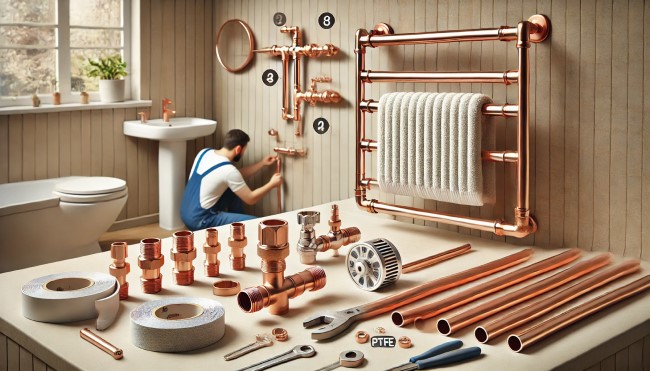How to Connect a Copper Pipe to a Towel Rail: A Step-by-Step Guide for DIY Plumbing

Connecting a copper pipe to a towel rail can seem challenging, but with the right knowledge and tools, it’s achievable even for beginners. This article will walk you through each step, ensuring your installation is secure, efficient, and ready to function effectively.
Why Connect Copper Pipes to a Towel Rail?
Towel rails, also known as towel radiators, provide a warm, cozy spot for your towels and contribute to the overall warmth of the bathroom. Copper pipes are durable, resistant to corrosion, and ideal for hot water systems, making them the perfect material for connecting to your towel rail.
Tools and Materials Needed
Before beginning, gather the necessary tools and materials to make your installation smooth and straightforward:
- Pipe cutter
- Adjustable wrench
- Pipe deburring tool
- Measuring tape
- Level
- Drill and suitable drill bits
- Radiator valves (angled or straight, depending on pipe configuration)
- PTFE tape (for sealing joints)
- Flux and solder (if using soldering method)
- Compression fittings (if avoiding soldering)
- Pipe insulation (optional but recommended for efficiency)
1. Planning Your Installation
Choosing the Location
The placement of your towel rail is crucial for both accessibility and efficient heating. Typically, towel rails are installed near the shower or bath to keep towels warm and within easy reach. Ensure there’s enough space for both the rail and the connecting pipes.
Determining the Pipe Route
To connect the copper pipe to the towel rail, carefully plan your pipe route. Determine if your setup requires straight or angled radiator valves based on where the copper pipes will meet the towel rail. This planning stage is essential to avoid unnecessary adjustments during installation.
2. Preparing the Copper Pipes
Measuring and Cutting the Pipes
Accurate measurements are key. Measure the required pipe lengths from the main water source to the towel rail inlet. Use a pipe cutter for clean cuts, ensuring a snug fit between each component.
Deburring the Pipes
After cutting, use a deburring tool to remove any sharp or uneven edges. This step prevents leaks and ensures the fittings connect securely to the towel rail.
3. Installing the Radiator Valves on the Towel Rail
Types of Radiator Valves
Radiator valves control the flow of water to your towel rail. Choose angled valves if the pipes are coming from below or straight valves if they’re coming from behind or the sides.
Attaching the Valves
Wrap PTFE tape around the valve threads to create a watertight seal, then screw each valve securely onto the towel rail inlet. Tighten the valve using an adjustable wrench, but avoid over-tightening as this could damage the threads.
4. Mounting the Towel Rail
Positioning and Marking
Hold the towel rail against the wall at the chosen height and position. Use a level to ensure it’s aligned properly, then mark the mounting points.
Drilling and Fixing
Drill holes at the marked points and insert wall plugs to secure the mounting brackets. Attach the brackets to the wall and then mount the towel rail. This is an essential step, as a stable installation prevents stress on the pipes, minimizing the risk of leaks.
5. Connecting the Copper Pipes to the Radiator Valves
Aligning the Pipes
Carefully align each copper pipe with the radiator valve. Check for accurate positioning to avoid any stress or twisting once connected.
Connecting with Soldering Method
For a permanent, secure connection, you may choose to solder the pipes to the valves:
- Apply flux to both the pipe end and the valve inlet.
- Insert the pipe into the valve.
- Use a propane torch to heat the joint until the solder melts and flows into the joint.
- Allow the joint to cool, forming a watertight seal.
Using Compression Fittings
If you prefer a simpler method, use compression fittings:
- Slide a compression nut and ring onto the pipe.
- Insert the pipe into the radiator valve inlet.
- Tighten the nut with an adjustable wrench to create a secure, leak-free connection.
6. Testing the System
Once you’ve connected the pipes, it’s time to test the installation.
Refilling and Bleeding the System
Turn on the water supply and let the system fill with water. Use a radiator key to bleed any trapped air from the towel rail, ensuring even heating.
Checking for Leaks
Inspect each connection closely for leaks. A small drip can indicate a loose fitting, which can be tightened. If you used soldering, any leakage might require reheating the joint or reapplying solder.
7. Insulating the Pipes (Optional)
To improve energy efficiency, insulate any exposed copper pipes. Pipe insulation helps reduce heat loss, ensuring your towel rail heats up more quickly and retains heat longer, saving energy and cost in the long run.
Tips for a Successful Installation
- Safety First: Turn off and drain the water supply before starting to avoid any flooding.
- Work Neatly: Use only the necessary amount of PTFE tape or flux to avoid buildup inside the pipe, which could restrict water flow.
- Check for Code Compliance: Ensure your installation complies with local building codes. If you’re uncertain, consult a professional.
- Consider an Extra Hand: Installing and aligning a towel rail can be easier with assistance, especially for heavier rails.
Troubleshooting Common Issues
Even with careful planning, you may encounter issues during installation. Here’s how to tackle some common problems:
- Leaking Joints: Re-tighten compression fittings or apply more solder as needed.
- Poor Heating Performance: Ensure air has been fully bled from the towel rail.
- Vibrating or Rattling Pipes: Check that pipes are securely fastened and insulated where necessary to minimize noise.
Benefits of Copper Pipes for Towel Rails
Using copper pipes in your towel rail installation offers several advantages:
- Durability: Copper pipes are highly resistant to corrosion, lasting longer than many alternatives.
- Heat Conductivity: Copper transfers heat efficiently, allowing for quicker and more effective towel rail warming.
- Easy Maintenance: Copper is easy to clean and maintain, ensuring your heating system remains in good condition.
Final Thoughts
Connecting a copper pipe to a towel rail may appear complex initially, but with the right guidance and tools, it’s an achievable DIY project. Whether you’re upgrading your bathroom or adding a new source of warmth, following these steps will help you install a towel rail that is functional, efficient, and visually appealing. Remember, if you’re unsure about any step, seeking professional assistance is always a good choice.



